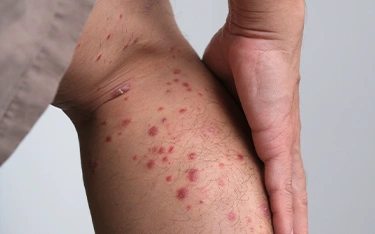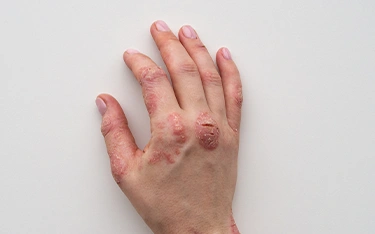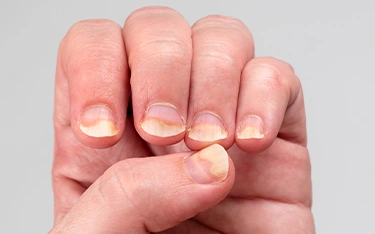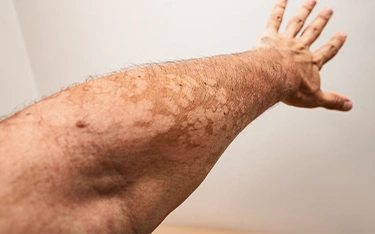Have you ever noticed dozens of tiny, red, drop-like spots that suddenly show up on your skin? This is especially common after recovering from a sore throat or experiencing a stressful life event. If your answer is yes, then you might be suffering from a skin condition known as guttate psoriasis.
This whole condition can be confusing and scary at first. One moment, your skin is fine, and the next, it looks like a bad insect bite or an allergic reaction. While it can look very dramatic, the good news is that, in most cases, it’s temporary.
When taken care of properly, many people see complete skin clearing within a few weeks or months.
What is Guttate Psoriasis?
When your body starts producing new skin cells faster than its normal rate, and the skin ends up looking red, inflamed, itchy and patchy, it’s called psoriasis. Guttate psoriasis is a form of psoriasis that occurs suddenly, often following a bacterial infection or strep throat.
In this condition, the body gets covered with small, red or pink, drop-shaped spots. The word “gutta” in Latin means “drop.” These spots typically appear on the trunk, upper arms, thighs, and sometimes the scalp. However, they can spread across large areas of the body.
Guttate psoriasis, although it can affect anyone, is especially common in:
- Children and teenagers
- Young adults under 30
- People with recent upper respiratory infections (especially strep throat)
- Those with a family history of psoriasis
- Individuals who are under emotional or physical stress for a long time
- People with either weakened or hyperactive immune systems.
PRO TIP: If you have never had psoriasis before but suddenly develop red spots after an illness, don’t panic. It could be guttate psoriasis, which often responds well to treatment or, luckily, even clears up on its own.
Many people often confuse guttate psoriasis with a different type of psoriasis called plaque psoriasis. Although they are both skin diseases, here’s how to differentiate them.
| Feature |
Guttate Psoriasis |
Effectiveness |
| Appearance |
Small, red, drop-like spots |
Thick, raised, silver-scaled plaques |
| Size of lesions |
Small (a few mm to 1 cm) |
Larger (often 1 inch or more) |
| Onset |
Sudden, often post-infection |
Gradual and chronic |
| Age of onset |
More common in children, teenagers, and young adults |
Often begins in adulthood |
| Course |
Often temporary, often resolves in weeks |
Chronic and recurring |
| Scales |
Lighter, finer, less silvery |
Thick, silvery, tightly adhered |
Symptoms of Guttate Psoriasis
Recognising the early signs and symptoms of guttate psoriasis is key not only to timely diagnosis but also to alleviating the anxiety that comes with skin changes. This condition doesn’t develop slowly, like some chronic skin issues. It often appears suddenly and drastically, catching people off guard.
Here’s what to look out for:
- The spots typically appear as small (2-10mm), round or oval, red or pink lesions.
- They often have thin layers of silvery-white scales on top. However, the scaling is much lighter and less flaky than other forms of psoriasis.
- Many describe them as someone who has splattered tiny red paint drops on the skin.
- Lesions may number from a few dozen to hundreds and tend to spread quickly across large areas, especially the torso.
These spots can appear suddenly, often after a respiratory infection or a highly stressful event. In people with darker skin tones, the spots may appear violet, grey, or dark brown instead of red, which can delay further diagnosis.
Also Read: Living with Upper Respiratory Tract Infections
The most common areas of the body where the lesions of guttate psoriasis appear are:
- Torso or trunk, which includes the neck, chest, belly, pelvis, and back
- Upper arms and thighs
- Neck and shoulders
- Occasionally, the scalp, face and behind the ears
- Rarely on the palms, soles, and genitals
Unlike the other types of psoriasis, the elbows and knees might not have lesions. This is also a distinguishing feature of guttate psoriasis. Now that we have defined the looks of the guttate psoriasis lesions, here is how you might feel if you are suffering from the same:
- Mildly to moderately itchy
- Sometimes, it feels like tightness, dryness, or a light burning sensation
- Rarely painful unless the skin becomes very dry or cracked
- To some people, even the light feeling of the clothes brushing against the skin can be uncomfortable
Triggers and Causes
You might be wondering, “Why did this even happen to me out of nowhere?” Guttate psoriasis often seems very sudden and unprovoked, but there is usually a hidden trigger behind the scenes.
Let’s look at what commonly sets it off:
Streptococcal infections
A recent strep infection is the most common reason for guttate psoriasis, especially:
- Strep throat
- Tonsillitis
- Sinus and respiratory infections
Guttate psoriasis typically shows up 1 to 3 weeks after the infection. The body’s immune system, which is hyperactive in fighting the strep bacteria, mistakenly starts attacking healthy skin cells. This process is called molecular mimicry, where the foreign antigen of strep resembles our skin cell antigens, and the body gets confused and attacks wrongly.
There are times when you may not have a history of previous infections but still develop guttate psoriasis. In such cases, a throat swab may still test positive, which means you had the infection but didn’t show any symptoms. That’s why doctors often screen for silent strep in patients with new guttate psoriasis.
Emotional stress
Stress is a powerful disruptor of the immune system. It doesn’t directly “cause” psoriasis, but it can trigger or worsen flares of guttate psoriasis.
Major stressors include:
- Academic pressure or job burnout
- Relationship issues
- Loss of a loved one
- Major life transitions like moving or changing careers
Also Read: Can Homeopathy Help Treat Stress?
Skin trauma or injury
This lesser-known cause of guttate psoriasis is called the Koebner response. In this, the guttate lesions appear exactly where the skin was injured. Some common triggers include:
- Scratching or picking the skin
- Sunburn
- Tattoos or piercings
- Insect bites
- Surgical scars
This is why it is important to avoid rough handling of the skin, especially during a flare-up or if you are predisposed to psoriasis.
Medications and immune disruption
Certain medicines can either trigger guttate psoriasis for the first time or exacerbate an existing condition.
The common culprits are:
- Beta-blockers (given for high blood pressure)
- Lithium (used in cases of bipolar disorder)
- Antimalarials
- NSAIDs like ibuprofen (can sometimes aggravate flares)
- Rapid withdrawal from oral steroids (can cause rebound flares)
Genetic and immune factors:
If someone in your family has any form of psoriasis, then you may also have inherited the tendency, even if you have never had any symptoms before. Guttate psoriasis is not often genetic, but the risk is much higher if close relatives have it.
Read more -





